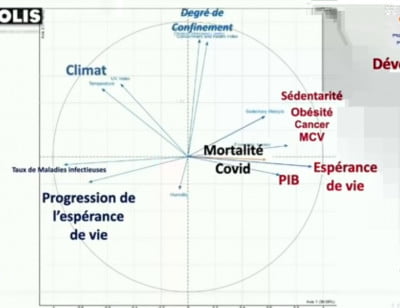Our saviors (and the friends of lockdown) claim that thanks to the measures we avoided the worst. And that now there is a need for new measures and lockdowns. The daily “buzz” revolves around strict compliance and the irresponsible. But what is the relationship between the measures and the evolution of the pandemic? An approach to this relationship was the subject of research by Jean Francois Toussaint, presented in the video above.
Jean Francois Toussaint is a French doctor, a professor holding a chair at the University of Paris – Descartes in Paris, and director of a public body, the IRMES (Institute for Biomedical Research and Epidemiology of Sport).
The video is from October 10, 2020. It is a lecture held as part of the Futurapolis Santé conference in Montpellier, France. Organizers include the University of Montpellier’s School of Medicine as well as numerous major sponsors (from Volvo to pharmaceutical companies), with LePoint enjoying exclusive coverage and broadcasting rights to the conference. We mention these details to emphasize that this is a strictly mainstream scientific event.
It refers to many and various issues about how we can monitor and assess the evolution of the COVID-19 “pandemic” worldwide. He is particularly concerned with examining whether the claims about a “second wave” are valid and whether the harsh lockdowns played any role in limiting the number of deaths.
We note indicatively:
“We are talking about a ‘second wave’ in the USA, when in reality the virus is shifting toward the southern states. In other words, it’s a geographic shift.”
“From the moment we changed strategy, when we began testing the general population, looking for the virus everywhere in the general population and not only in those who arrived sick at hospitals, the létalité (mortality relative to confirmed positive cases) of the virus has not stopped falling. It has dropped by 60% since May.”
In summary, the video presents the following:
He conducts a study in which he tries to find out which factors played a role in the number of COVID deaths in each region of the world. He calls it étude univariée, that is, a study that examines different kinds of factors that played a role in the evolution of the epidemic and ultimately tries to find the relationships that govern these factors. It is based on the official data that each country provides regarding its cases and deaths.
It is divided into five basic categories/criteria:
- Age (life expectancy in each country, region, etc.)
- Metabolism (eating habits, areas with high or low obesity rates, etc.)
- Economy (developed countries, third-world countries, etc.)
- Environment (temperature, climate, etc.)
- Politics (political decisions, measures, lockdowns, etc.).
He tries to see the relationships between these different factors, to understand how the epidemic evolved and whom the virus “targeted.”
As far as Age is concerned, it generally appears that the regions/countries with a higher life expectancy (and therefore more elderly people) have higher COVID mortality rates (per 100,000 inhabitants).
Regarding Metabolism, it examines factors such as lack of physical exercise and obesity, which in general appear to be linked to higher mortality rates per 100,000 inhabitants.
Regarding the Economy, it examines factors such as per capita income (higher mortality rates per 100,000). Also: countries with higher mortality rates from infectious diseases in general in their population, i.e., third-world countries, “developing countries” have lower mortality rates per 100,000.
Regarding the Environment/Climate, there is a relationship between heat and humidity and fewer deaths per 100,000, although it is not as decisive as the previous factors. It is quite interwoven and is influenced as a factor by the others.
At the end it presents a graph that collectively shows the relationships between the different factors. There it also introduces the fifth factor, the Politics that each region followed in response to the epidemic.
The conclusions reached, summarizing the above and relating all these factors regarding Covid mortality, are as follows:
Life expectancy plays a role in Covid mortality. Countries with high life expectancy have higher mortality. Countries with lower life expectancy, which increases year by year—the “developing countries”—have lower mortality. Countries with a high percentage of infectious diseases in their population have lower mortality. Countries with obesity, cardiovascular diseases, cancers, and degenerative diseases (Alzheimer’s, etc.) in their population—the developed countries—have higher mortality. Countries with higher per capita income have higher mortality. Climate plays a role, but a weaker one, less clear and highly dependent on the other factors.
And finally, the political measures of discipline that the states took, the lockdowns and their severity, play almost no role in mortality—almost zero role. Toussaint explicitly says that there is no relationship between mortality and whether or not quarantine is imposed on the population. The opposite is probably happening, as Toussaint says. It seems that the measures follow COVID. The more deaths and now the more cases, the more and stricter the measures. The measures come second.
It concludes by showing the number of deaths in hospitals in France, at the beginning of the epidemic and now, refuting in an indisputable manner—since the numbers are before us and indisputable—the existence of a “second wave,” etc., because the daily deaths in hospitals in France are now far fewer than at the peak of the epidemic, and the mortality relative to reported cases is much lower.

